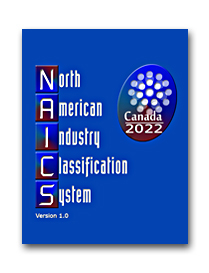
 |
| Background |
In 1994, the statistical agencies of Canada, Mexico, and the United States agreed to jointly develop the North American Industry Classification System (NAICS), an industry classification of the economic activities in North America. The classification system replaces former industry classifications and provides a framework for the collection, analysis and dissemination of economic statistics that allows an accurate assessment and comparison of the economies of the region.
The three countries continue to coordinate their efforts for further development and revision of NAICS through Statistics Canada, the United States Economic Classification Policy Committee (on behalf of the Office of Management and Budget), and the National Institute of Statistics and Geography (INEGI, by its Spanish acronym) of Mexico.
| Conceptual framework |
NAICS is uniquely constructed within a single conceptual framework: the supply-based or production-oriented economic concept, which guided its development. In NAICS, activities with similar production processes are classified in the same category, and those with different production processes are classified in different categories.
NAICS was systematically developed following this single principle, always under the same rationale, thus helping to avoid controversy and misinterpretation.
| Relationship between NAICS and ISIC |
Reference classifications1 provide a common structure that allows greater homogeneity between classifications in terms of hierarchies, concepts, purpose, revision cycles and data dissemination.
Hence, in order to meet the need not only for regional but for international comparability of economic statistics, the statistical agencies of Canada, Mexico and the United States agreed to establish links between categories of NAICS and the International Standard Industrial Classification of All Economic Activities (ISIC), the United Nations reference classification of productive economic activities, in such a way that data collected with NAICS could be regrouped under the ISIC structure. Taking this agreement into account when developing the original version (NAICS 1997), the statistical agencies of the three countries strove to create categories that did not cross ISIC Rev. 3 two-digit boundaries. Revisions to NAICS for 2002, 2007, 2012, 2017 and 2022 (for Canada) and NAICS 2002, 2007, 2012, 2017 and 2022 (for the United States) and NAICS 2002, 2007, 2013, 2018 and 2023 (for Mexico2), were undertaken fulfilling the same objective, although ISIC Rev. 4 provided the correspondence framework for NAICS 2007,2012, 2017 and 2022 (for Canada)/2007, 2012, 2017 and 2022 (for the United States)/2013, 2018 and 2023 (for Mexico). It should be emphasized that ISIC Rev. 4 is the outcome of a review process that involved contributions from classifications experts from around the world, including NAICS experts, and therefore the ISIC Rev. 4 structure is more detailed than the previous version, especially in the case of services, which makes it more compatible with the latest NAICS version.
Therefore, the statistics collected with NAICS are comparable to those produced based on ISIC and with the statistics presented with other classifications that use ISIC as their reference classification.
1Reference classifications are officially approved and recommended by the United Nations Statistical Commission and other competent authorities, such as the International Labour Organization (ILO), the International Monetary Fund (IMF), the United Nations Educational, Scientific and Cultural Organization (UNESCO), the World Health Organization (WHO), and the World Customs Organization (WCO), depending on the subject matter. Since reference classifications are officially recommended by the UN Statistical Commission, they may be used as models for the development or revision of other classifications in terms of the structure, nature and definition of the categories.
2It is worth noting that for the latest NAICS revision, INEGI, as the institution responsible for regulating and coordinating the National System of Statistical and Geographical Information (SNIEG, by its Spanish acronym), undertook the “Public Consultation to the Methodology of the North American Industry Classification System (NAICS )” as part of the classification’s revision process for the 2023 version. INEGI's Governing Board set the period from April 14 to May 13, 2020 for the Public Consultation on SCIAN 2023, based on articles 77 section XVII and 88 of the Law of the National System of Statistical and Geographic Information, and numeral 5 of the General Guidelines for the Publication of Methodologies that the National Institute of Statistics and Geography uses in the Production of Information of National Interest. However, due to the health emergency generated by the SARS-CoV-2 virus, the Public Consultation period was extended from April 14 to May 27 in order to give users more opportunity to participate in it. Due to the periods in which the Public Consultations were held in Mexico, Mexico’s latest national version is referred to as SCIAN 2023, while Canada’s and the United States’ national versions refer to 2022, but they all are the same classification, using different names.
| Updating NAICS |
NAICS was adopted in 1997 (NAICS 1997) and updated for 2002, 2007, 2012, 2017 Version 1.0, 2017 and 2022 (Canada)/2002, 2007, 2012, 2017 and 2022 (United States)/2002, 2007, 2013, 2018 and 2023 (Mexico) based on the trilateral agreement of the statistical agencies to produce five-year revisions. It should be noted that the versions are all NAICS classifications but use different year numbers and that each new version replaces the previous one.
  
|
| NAICS sectors |
NAICS consists of 20 economic sectors. Table 1 below shows the codes and titles for each of the NAICS sectors.
Table 1. NAICS sectors
|
| NAICS structure and aggregation levels |
NAICS is composed of five aggregation levels: sector (the most aggregated level, identified by two digits), subsector (designated by three digits), industry group (four digits), industry (five digits) and national industry (the most detailed level, identified by six digits). The name of each level and the corresponding digit designations are shown below:
Table 2. NAICS aggregation levels
|
The NAICS structure meets the needs of the three countries through the use of the national industry level of aggregation. National classifications are called NAICS Canada, NAICS United States and SCIAN Mexico. It should be emphasized that there is no single version that comprises the three countries’ NAICS/SCIAN classifications, since each one has its own national version.
Most trilateral agreements3 were established at the industry level; however, some were reached at higher levels due to differences in the organization of economic units, distinct regulations, diverging interests in levels of disaggregation, and time and resource constraints.
For NAICS 2022 (Canada)/2022 (U.S.)/2023 (Mexico), in order to indicate the trilaterally agreed categories, Mexico and the United States used a “T” superscript on the title. The titles without that letter are country-specific categories. Canada placed the “CAN” symbol at the end of the titles of Canadian industries only; “US” when Canadian and United States industries are comparable, and “MEX” when Canadian and Mexican industries are comparable, and nothing when there is trilateral agreement.
An example of the NAICS structure follows:
Table 3. Example of NAICS structure
|
The national industry is reserved for each country’s national detail according to its needs. Thus the number of detailed industries below the five-digit level may vary from country to country. The same code might be used for different national industries, so it is indispensable to fully read the code, title and description of all categories.
Finally, Table 4 compares the counts of NAICS 2022 (Canada), 2022 (United States)/2023 (Mexico) sectors, subsectors, industry groups, industries, and national industries for each country:
Table 4. Number of categories per level for NAICS 2022 (Canada)/2022 (United States)/2023 (Mexico)
3 In the context of NAICS, trilateral agreements are those endorsed by all three countries that developed the classification, implying the NAICS level (sector, subsector, industry group or industry) which is comparable among the three countries, and for which the three have the same understanding on its content and the scope of the categories. |
Categories arrangement (code, title, description) |
Each NAICS category, from sector to national industry level, comprises: a) the numerical code; b) the title or name of the category, and c) the category description. Consider the following example:
| 541212 Offices of accountantsCAN |
|
| This Canadian industry comprises establishments primarily engaged in providing a range of accounting services, such as the preparation of financial statements, the preparation of management accounting reports, the review and auditing of accounting records, the development of budgets, the design of accounting systems, and the provision of advice on matters related to accounting. | |
| Inclusion(s) | |||
• provision of related services, such as bookkeeping, tax return preparation, payroll, management consulting and insolvency |
|||
| Illustrative example(s) | |||
• accountant, professional |
|||
| Exclusion(s) | |||
• providing bookkeeping, billing and payroll processing services, without also providing accounting or auditing services (see 541215 Bookkeeping, payroll and related services)
|
|||
| a) | Numerical code. Every category has a numerical code that identifies it. The code’s number of digits varies according to the level. Code digits allow identifying the more aggregate levels in which the economic activity is included. For example, industry 541212, “Offices of accountants” is part of the following categories: sector 54, subsector 541,industry group 5412, and industry 54121. Codes have other distinctive features: A national industry code ending in zero indicates it is the only national industry of the industry. A code ending in nine, from the subsector to national industry levels, generally indicates the content of the category is residual with regard to other categories within its same level. |
|
| b) | Title. The category’s title or name identifies the primary activity, under which the information of all activities carried out in the economic unit is classified and presented. Categories belonging to different levels but with the same content have the same title. This is because the lower-level category is the only breakdown of the higher-level category, as in the case of a national industry whose last digit is zero. |
|
| c) | Description. The description of every NAICS category provides detailed information regarding its content. The descriptions by Canada, Mexico and the United States have a basic structure composed of three parts, even though they are named and ordered differently: | |
Table 5. Organization of Descriptions
|
| Acknowledgements |
Every updated NAICS version reveals only the end result of the work carried out by the staff from Statistics Canada, the United States Economic Classification Policy Committee and INEGI of Mexico. Due to their effort, painstaking analysis, and spirit of constant improvement, NAICS remains updated to provide a single framework for the collection, analysis and dissemination of economic statistics and to ensure, in turn, the users’ needs are met by the classification.
The statistical agencies of Canada, Mexico and the United States express their gratitude for their users’ valuable contributions submitted through the public consultation process, while inviting them to continue to participate in order to refine the classification and achieve uniformity and comparability in the presentation of data describing the economy of the three countries.
Each country’s classification can be reviewed in detail by following these links:
NAICS Canada |
|
NAICS United States |
|
SCIAN México |
|